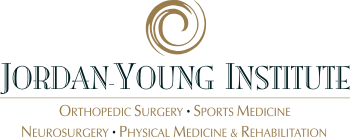Elbow
- Anatomy
- Conditions
- Procedures
Elbow Anatomy
The elbow is a complex joint formed by the articulation of three bones –the humerus, radius and ulna. The elbow joint helps in bending or straightening of the arm to 180 degrees and assists in lifting or moving objects.
The bones of the elbow are supported by:
- Ligaments and tendons
- Muscles
- Nerves
- Blood vessels
Bones and Joints of the elbow joint
The elbow joint is formed at the junction of three bones:
- The Humerus (upper arm bone) forms the upper portion of the joint. The lower end of the humerus divides in to two bony protrusions known as the medial and lateral epicondyles which can be felt on either side of the elbow joint.
- The Ulna is the larger bone of the forearm located on the inner surface of the joint. The curved shape of the ulna articulates with the humerus.
- The Radius is the smaller bone of the forearm situated on the outer surface of the joint. The head of the radius is circular and hollow which allows movement with the humerus. The connection between the ulna and radius helps the forearm to rotate.
The elbow consists of three joints because of articulation of the three bones namely:
- Humero-ulnar joint is formed between the humerus and ulna and allows flexion and extension of the arm.
- Humero-radial joint is formed between the radius and humerus, and allows movements like flexion, extension, supination and pronation.
- Radio-ulnar joint is formed between the ulna and radius bones, and allows rotation of the lower arm.
Articular cartilage lines the articulating regions of the humerus, radius and ulna. It is a thin, tough, flexible, and slippery surface that acts as a shock absorber and cushion to reduce friction between the bones. The cartilage is lubricated by synovial fluid, which further enables the smooth movement of the bones.
Muscles of the Elbow Joint
There are several muscles extending across the elbow joint that help in various movements. These include the following:
- Biceps brachii: upper arm muscle enabling flexion of the arm
- Triceps brachii: muscle in the back of the upper arm that extends the arm and fixes the elbow during fine movements
- Brachialis: upper arm muscle beneath the biceps which flexes the elbow towards the body
- Brachioradialis: forearm muscle that flexes, straightens and pulls the arm at the elbow
- Pronator teres: this muscle extends from the humeral head, across the elbow, and towards the ulna, and helps to turn the palm facing backward
- Extensor carpi radialis brevis: forearm muscle that helps in movement of the hand
- Extensor digitorum: forearm muscle that helps in movement of the fingers
Elbow joint ligaments and tendons
The elbow joint is supported by ligaments and tendons, which provide stability to the joint.
Ligaments are a group of firm tissues that connect bones to other bones. The most important ligaments of the elbow joint are the:
- Medial or ulnar collateral ligament: comprised of triangular bands of tissue on the inner side of the elbow joint.
- Lateral or radial collateral ligament: a thin band of tissue on the outer side of the elbow joint.
Together, the medial and lateral ligaments are the main source of stability and hold the humerus and ulna tightly in place during movement of the arm.
- Annular ligament: It is a group of fibers that surrounds the radial head, and holds the ulna and radius tightly in place during movement of the arm.
The ligaments around a joint combine to form a joint capsule that contains synovial fluid.
Any injury to these ligaments can lead to instability of the elbow joint.
Tendons are bands of connective tissue fibers that connect muscle to bone. The various tendons which surround the elbow joint include:
- Biceps tendon: attaches the biceps muscle to the radius, allowing the elbow to bend
- Triceps tendon: attaches the triceps muscle to the ulna, allowing the elbow to straighten
Nerves of the elbow joint
The main nerves of the elbow joint are the ulnar, radial and median nerves. These nerves transfer signals from the brain to the muscles that aid in elbow movements. They also carry the sensory signals like touch, pain, and temperature back to the brain.
Any injury or damage to these nerves causes pain, weakness or joint instability.
Blood vessels:
Arteries are blood vessels that carry oxygen-pure blood from the heart to the hand. The main artery of the elbow is the brachial artery that travels across the inside of the elbow and divides into two small branches below the elbow to form the ulnar and the radial artery.
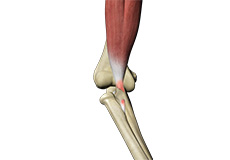
Distal Biceps Rupture
The biceps muscle located in the front of the upper arm allows you to bend the elbow and rotate the arm. Biceps tendons attach the biceps muscle to the bones of the shoulder and the elbow.
Biceps tear can be complete or partial. Although two tendons attach the biceps muscle to the bones at the shoulder, only one tendon attaches it to the elbow.
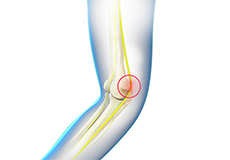
Ulnar Neuropathy
Ulnar neuropathy is characterized by injury to the ulnar nerve, the nerve that travels across the elbow from the shoulder to the hand and helps you to move your hand and wrist. Damage to the nerve slows down or stops signals being sent across the nerve.

Tennis Elbow (Lateral Epicondylitis)
Tennis elbow is the common name used for the elbow condition called lateral epicondylitis. It is an overuse injury that causes inflammation of the tendons that attach to the bony prominence on the outside of the elbow (lateral epicondyle). It is a painful condition occurring from repeated muscle contractions at the forearm that leads to inflammation and micro tears in the tendons that attach to the lateral epicondyle.

Golfer’s Elbow (Medial Epicondylitis)
Golfer’s elbow, also called medial epicondylitis, is a painful condition occurring from repeated muscle contractions in the forearm that leads to inflammation and microtears in the tendons that attach to the medial epicondyle. The medial epicondyle is the bony prominence that is felt on the inside of the elbow.
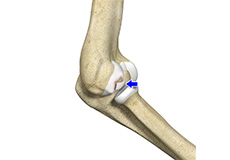
Osteochondritis Dissecans of the Capitellum
Coming soon
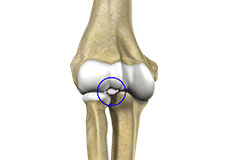
Loose Bodies in the Elbow
Your elbow is a joint made up of three bones held together by muscles, ligaments, tendons, and cartilage. It is both a hinge and pivot joint allowing you to bend and rotate your elbow freely. Loose bodies in your elbow are small pieces of bone or cartilage that have broken off and are lying or floating free within the joint. They can make elbow movement such as bending or rotation difficult.
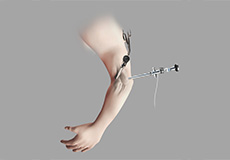
Elbow Arthroscopy
Elbow arthroscopy, also referred to as keyhole or minimally invasive surgery, is performed through tiny incisions to evaluate and treat several elbow conditions.
Arthroscopy is a surgical procedure in which an arthroscope, a small soft flexible tube with a light and video camera at the end, is inserted into a joint to evaluate and treat a variety of conditions.
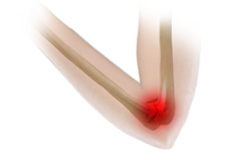
Tommy John Surgery (UCL Reconstruction)
If conservative treatment options fail to resolve the condition and symptoms persist for 6-12 months, your surgeon may recommend ulnar collateral ligament reconstruction surgery. UCL reconstruction surgery repairs the UCL by reconstructing it with a tendon from the patient’s own body (autograft) or from a cadaver (allograft). The most frequently used tissue is the palmaris longus tendon in the forearm.
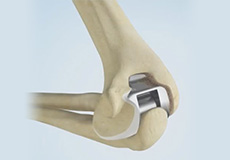
Total Elbow Replacement
Elbow Joint Replacement, also referred to as Total Elbow Arthroplasty, is an operative procedure to treat the symptoms of arthritis that have not responded to non-surgical treatments.
Elbow joint replacement surgery may be recommended by your surgeon for the treatment of severe arthritis that has not responded to conservative treatment options such as medications or steroid injections.
